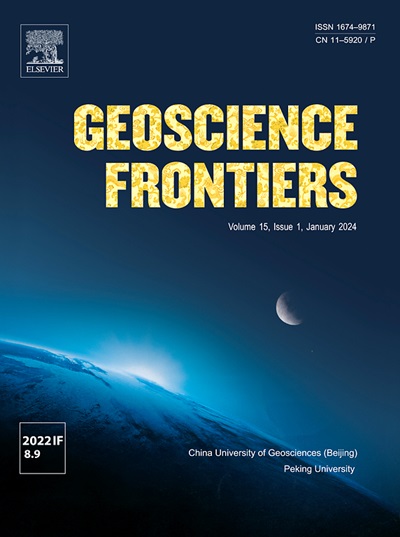环境地球化学和微生物变量对北印度洋冷渗生态系统细菌多样性的影响
IF 8.9
1区 地球科学
Q1 GEOSCIENCES, MULTIDISCIPLINARY
引用次数: 0
摘要
冷渗漏是海底碳氢化合物排放路径周围生物群落的绿洲。微生物利用甲烷和其他碳氢化合物产生的产物为这些地点丰富的化学合成群落提供燃料。2018年2月,在印度东海岸克里希纳-戈达瓦里盆地(K-G盆地)的冷渗生态系统中发现了一个这样的地点,深度为1800米,对其细菌多样性进行了评估。渗漏菌群以变形菌门(57%)、厚壁菌门(16%)和幽门杆菌科未分类种为主。表层沉积物最大OTUs(可操作分类单位)为2.27 × 103, Shannon α多样性指数为8.06。一般情况下,总有机碳(p <;0.01),硫酸盐(p <;0.001),硫化物(p <;0.05)和甲烷(p <;0.01)是形成K-G盆地冷渗生态系统细菌群落的主要原因。环境参数对不同冷渗环境下海洋细菌多样性丰富度的变化起着重要作用。本文章由计算机程序翻译,如有差异,请以英文原文为准。

Influence of ambient geochemical and microbiological variables on the bacterial diversity in a cold seep ecosystem in North Indian Ocean
Cold seeps are oases for biological communities on the sea floor around hydrocarbon emission pathways. Microbial utilization of methane and other hydrocarbons yield products that fuel rich chemosynthetic communities at these sites. One such site in the cold seep ecosystem of Krishna-Godavari basin (K-G basin) along the east coast of India, discovered in Feb 2018 at a depth of 1800 m was assessed for its bacterial diversity. The seep bacterial communities were dominated by phylum Proteobacteria (57%), Firmicutes (16%) and unclassified species belonging to the family Helicobacteriaceae. The surface sediments of the seep had maximum OTUs (operational taxonomic units) (2.27 × 103) with a Shannon alpha diversity index of 8.06. In general, environmental parameters like total organic carbon (p < 0.01), sulfate (p < 0.001), sulfide (p < 0.05) and methane (p < 0.01) were responsible for shaping the bacterial community of the cold seep ecosystem in the K-G Basin. Environmental parameters play a significant role in changing the bacterial diversity richness between different cold seep environments in the oceans.
求助全文
通过发布文献求助,成功后即可免费获取论文全文。
去求助
来源期刊

Geoscience frontiers
Earth and Planetary Sciences-General Earth and Planetary Sciences
CiteScore
17.80
自引率
3.40%
发文量
147
审稿时长
35 days
期刊介绍:
Geoscience Frontiers (GSF) is the Journal of China University of Geosciences (Beijing) and Peking University. It publishes peer-reviewed research articles and reviews in interdisciplinary fields of Earth and Planetary Sciences. GSF covers various research areas including petrology and geochemistry, lithospheric architecture and mantle dynamics, global tectonics, economic geology and fuel exploration, geophysics, stratigraphy and paleontology, environmental and engineering geology, astrogeology, and the nexus of resources-energy-emissions-climate under Sustainable Development Goals. The journal aims to bridge innovative, provocative, and challenging concepts and models in these fields, providing insights on correlations and evolution.
 求助内容:
求助内容: 应助结果提醒方式:
应助结果提醒方式:


